Per @DanielGlassey , onboard is needed to get the OSK in Keyman for Linux.
I also have a MacBook Pro with macOS Mojave, and I don’t see either of these problems with Keyman 11.0.200. The “about” item shows text with the image and typing ka in the Amharic keyboard gives “ካ”
Do you have problems with other keyboards beside the Amharic one?
Maybe one of the developers can chime in with some troubleshooting tips. Would removing Keyman and reinstalling it again help?
Our macOS developer has reproduced the first issue you describe. He’s looking into it now.
For the second issue, which app(s) is this occurring in? Can you test also in TextEdit?
I did a complete uninstall and reinstall of keyman on my macbook. previously i had simply copied the new keyman on top of the old. the behavior remains the same.
The keyboard works fine with TextEdit, Safari and Sublime. But has the composition issue with Chrome 71.0.3578.98 and MS Word 16.16.5 .
So far, I have exclusively distributed kmx (or kmn for kmfl) files, and have never generated .kmp packages. But keyman for linux only accepts .kmp?
Justin, I expect this is by design. I asked this question last Feb about Keyman for MacOS accepting kmx files, this is what Mark D wrote:
@Justin_Luth - yes, the .kmp package is a lot easier to distribute.
Here’s a guide on using Keyman Developer to create a keyboard package:
https://help.keyman.com/developer/10.0/guides/distribute/tutorial/
Another experience with the 11.0.200 osx build is that when I select from the MS Word font menu, or font size menu, it triggers the keyman onscreen keyboard to pop up.
The instructions for installing “Keyman for Linux 11.0 beta” say: “On Ubuntu (gnome-shell) you need to install the Input Source in Region & Language Settings.” This is not obvious to me. Are there more detailed instructions somewhere? For example, if I want to install the EuroLatin keyboard and use it to type French, what should I do (on a standard Ubuntu 18.04 install)?
I’ve created issue #1523 for this. Can you update it with your macOS version and applicable details?
Hi @drowe, we are working on the documentation for Linux installation – at present the beta is available on the assumption that you’d already be familiar with your Linux distribution’s language configuration. We do aim to have documentation for popular distros available by release date.
FWIW, km-config from the console is a good starting point for downloading and installing keyboard packages.
Note that km-config only installs the keyboard into IBus. The step to “install the Input Source in Region & Language Settings.” is needed for it to be used in gnome-shell.
https://help.gnome.org/users/gnome-help/stable/keyboard-layouts.html.en is the Gnome instructions for adding an input source.
For your French example on a system installed as English which doesn’t have French language installed in Manage installed languages on Region & Language settings. First you install the eurolatin keyboard in “Keyman Keyboards”. Then go to the Region & Language settings. The input source will be in Otherand it is called French (EuroLatin (SIL))
Thanks, Daniel, for those pointers. Here’s what I ended up doing:
-
opened “Settings”, “Region & Language”
-
clicked on the “+” below “Input Sources”
-
clicked on the three dots to expand the list (since there are a number of flavo(u)rs of English installed)
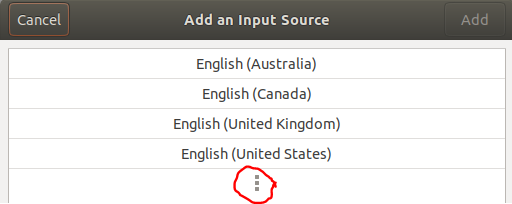
-
scrolled down to “Other” and clicked on it
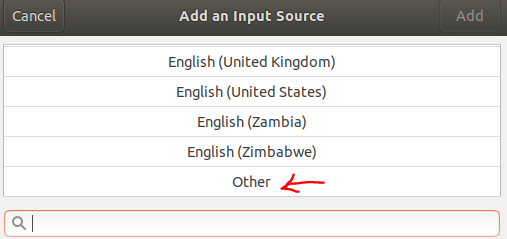
The first time I got to this point, Settings froze up and I had to terminate it and start over. The second time it worked, bringing up a long list of languages. I typed in “french” and scrolled to the “French (EuroLatin (SIL))” entry.
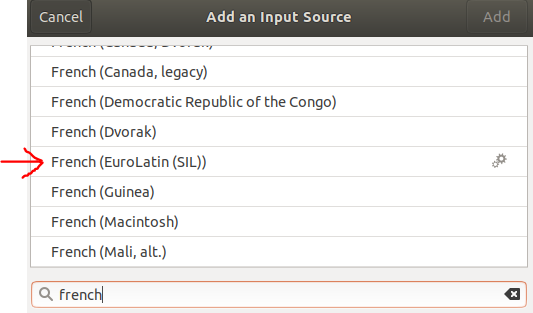
I clicked on that entry, then the “Add” button in the top right corner of the dialog. The new item was added to “Input Sources”:
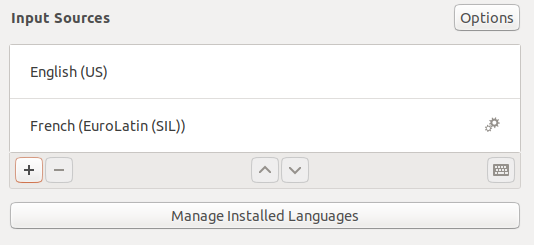
and a dropdown selection list was added:
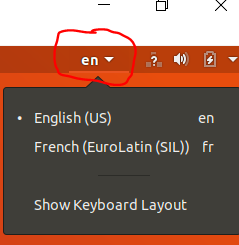
Thanks,
David
That looks like a great capture for the docs when they get online… 
Just some general questions/feature requests (I haven’t try version 11, as am still familiarizing with version 10).
-
Is there any automation tool to test a list of keystrokes? Because I have a complex keyboard and when I changed something I want to make sure it still correct for the rest of the stuff that I tested correctly before.
-
And then for context offset, it would be nice to have something like ‘context(1-3)’ instead of ‘context(1) context(2) context(3)’
-
Is it a bug that I cannot do a redo (Ctrl+Y), or is it on purpose? I can do Undo (Ctrl+Z), but redo doesn’t seem to work.
-
It seems that the keyboard rules only work if someone typed it in succession. In other word ‘a’ + ‘b’ > ‘c’ would work if typed in succession, but if I type ‘a’ and go to another line, and go back to ‘a’, typed ‘b’, I would get ‘ab’. So it doesn’t look up what’s the character before, if it’s not typed in succession?
Thank you for the excellent program.
Keyman Developer 11 replaces the underlying code editor with Monaco (a la Visual Studio Code). Using the latest 11.0.1306.0 beta, I can Redo (Shift+Ctrl+Z)
Contexts (and deadkeys) are intentionally cleared when navigating to different lines.
To clarify this a little: modern applications, such as Microsoft Word, that fully support the Text Services Framework, have the ability to report the context to Keyman so contextual input is maintained when moving around the document. Deadkeys are always cleared when location is updated, as they are ephemeral state markers.
Keyman Developer does include a ‘regression testing’ tool. It is in need of some tender loving care as it is getting a bit old, but it does still work. We plan to introduce more robust and extensive unit testing for keyboard layouts in a future version of Keyman Developer.
If you would like to suggest this as a future feature, please visit Sign in to GitHub · GitHub.
I’m really glad Keyman Developer is working for you ![]()
When packaging, selecting keyboard - add, the add window shows briefly and then disappears into the background. I have to press “esc” to cancel it because I can’t find a way to switch to it. Alt-tab doesn’t work to switch to it. Similarly, “help - about” also briefly shows and then fades behind the application. (keymandeveloper-11.0.1307.0 on Windows 7 SP1)
UPDATE: Must have been a UI-library glitch. Closing the program and restarting it fixed that problem. The “hidden in the background” problem started happening to other areas where it had worked earlier…
Sounds like a weird issue. Glad it’s gone away … but let us know if it recurs!
